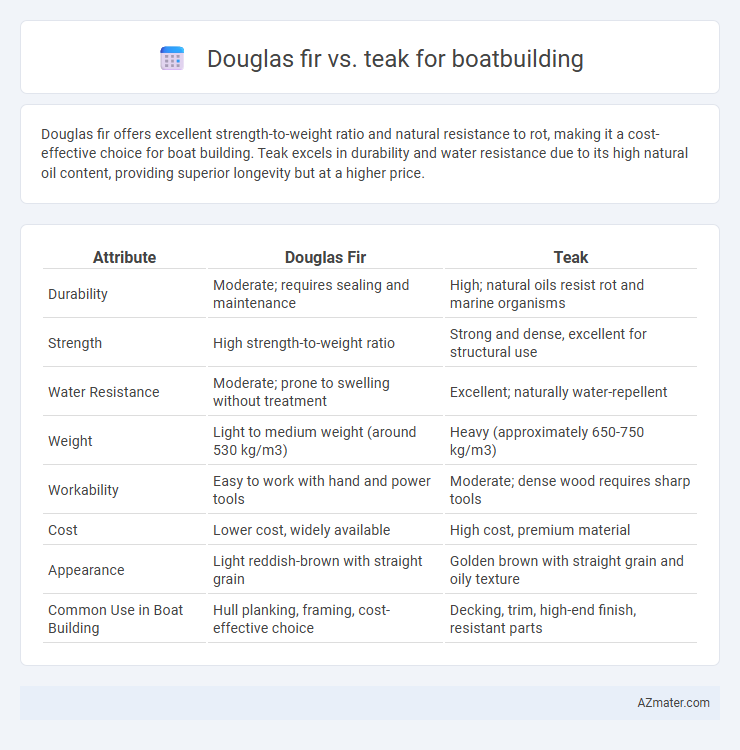Douglas fir offers excellent strength-to-weight ratio and natural resistance to rot, making it a cost-effective choice for boat building. Teak excels in durability and water resistance due to its high natural oil content, providing superior longevity but at a higher price.
Table of Comparison
| Attribute | Douglas Fir | Teak |
|---|---|---|
| Durability | Moderate; requires sealing and maintenance | High; natural oils resist rot and marine organisms |
| Strength | High strength-to-weight ratio | Strong and dense, excellent for structural use |
| Water Resistance | Moderate; prone to swelling without treatment | Excellent; naturally water-repellent |
| Weight | Light to medium weight (around 530 kg/m3) | Heavy (approximately 650-750 kg/m3) |
| Workability | Easy to work with hand and power tools | Moderate; dense wood requires sharp tools |
| Cost | Lower cost, widely available | High cost, premium material |
| Appearance | Light reddish-brown with straight grain | Golden brown with straight grain and oily texture |
| Common Use in Boat Building | Hull planking, framing, cost-effective choice | Decking, trim, high-end finish, resistant parts |
Introduction: Douglas Fir vs Teak in Boat Building
Douglas fir and teak are prominent choices in boat building due to their distinct properties and durability. Douglas fir offers a high strength-to-weight ratio and excellent resistance to warp and shrinkage, making it ideal for structural components like frames and planking. Teak stands out with its natural oils and dense grain, providing exceptional water resistance, longevity, and aesthetic appeal, often used for decking and interior finishes.
Wood Origins and Availability
Douglas fir, sourced primarily from the Pacific Northwest of the United States and Canada, is abundant and widely available due to sustainable forestry practices in these regions. Teak originates mainly from Southeast Asia, particularly Myanmar, Thailand, and Indonesia, and its availability is limited by slower growth rates and stringent export regulations. The widespread accessibility of Douglas fir contrasts with the scarcity and higher cost of teak, affecting their suitability for large-scale boat building projects.
Strength and Structural Properties
Douglas fir exhibits high strength-to-weight ratio and excellent stiffness, making it a preferred choice for boat frames and structural components where durability and load-bearing capacity are critical. Teak offers exceptional natural resistance to water, decay, and marine organisms, combined with moderate strength and superior dimensional stability, which enhances the longevity of exposed boat surfaces. While Douglas fir provides superior structural strength, teak's durability against harsh marine environments makes it ideal for decks and exterior trim in boat building.
Durability in Marine Environments
Douglas fir offers high strength-to-weight ratio and moderate durability in marine environments but requires regular maintenance to prevent rot and fungal attacks. Teak is renowned for exceptional natural oils and dense grain that provide superior resistance to water, decay, and marine borers, making it a preferred choice for long-lasting boat decking and trim. Choosing teak enhances durability and lifespan in harsh saltwater conditions, whereas Douglas fir demands protective coatings to achieve similar performance.
Resistance to Rot and Decay
Douglas fir exhibits moderate resistance to rot and decay, making it suitable for interior boat building components but requiring protective treatments for prolonged water exposure. Teak naturally contains oils and silica, providing exceptional resistance to rot, decay, and marine borers, which makes it a preferred choice for exterior boat decking and hull applications. The superior durability of teak in harsh marine environments often justifies its higher cost compared to Douglas fir.
Workability and Ease of Shaping
Douglas fir offers excellent workability due to its straight grain and moderate hardness, making it easier to shape and fasten during boat building. In contrast, teak's dense and oily nature poses challenges in machining and shaping but provides superior durability once worked. Woodworkers often prefer Douglas fir for intricate components, while teak is favored for its natural resistance and longevity despite being harder to shape.
Weight and Impact on Boat Performance
Douglas fir's lower density, approximately 530 kg/m3, contributes to lighter boat construction, enhancing speed and fuel efficiency by reducing overall weight. In contrast, teak, with a density around 660 kg/m3, adds more weight but offers superior durability and natural resistance to seawater and rot, which can improve long-term vessel integrity and reduce maintenance costs. Choosing Douglas fir optimizes performance through weight reduction, while teak provides enhanced structural resilience at the expense of increased weight.
Maintenance Needs and Longevity
Douglas fir offers moderate durability and requires regular maintenance such as sealing and varnishing to prevent moisture damage and decay in boat building. Teak is highly valued for its natural oils and dense grain, providing exceptional resistance to rot, insects, and water, resulting in lower maintenance needs and longer lifespan. Choosing teak enhances longevity and reduces upkeep costs compared to Douglas fir in marine environments.
Cost Comparison and Value
Douglas fir offers a cost-effective option for boat building due to its affordability and widespread availability, making it ideal for budget-conscious projects. Teak commands a higher price because of its exceptional durability, natural resistance to rot, and low maintenance, providing long-term value despite the upfront expense. While teak's premium cost is justified by longevity and superior performance in marine environments, Douglas fir presents a practical balance between cost and functionality for many boat builders.
Best Applications and Final Recommendations
Douglas fir offers excellent strength-to-weight ratio and natural resistance to rot, making it ideal for structural components and framing in boat building. Teak provides superior durability, water resistance, and a naturally oily texture, which is perfect for decking, trim, and exterior applications requiring high exposure to moisture. For optimal boat construction, use Douglas fir for the framework and teak for exposed, high-wear surfaces to combine strength and longevity.

Infographic: Douglas fir vs Teak for Boat building
 azmater.com
azmater.com